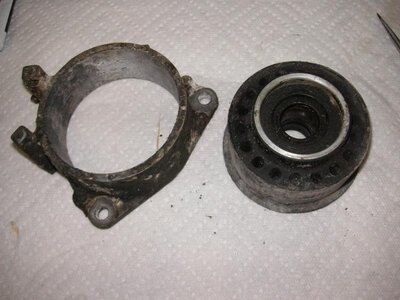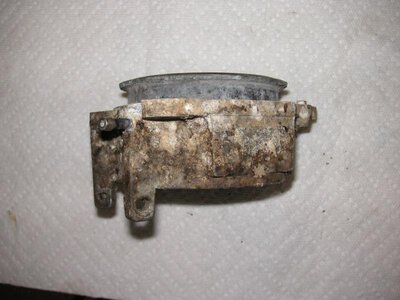There seems to be alot of confusion among many freeriders about midshafts aka intermediate or short shafts.
Midshafts
All years of Yamaha Superjets (1990-2020) and Waveblaster 1's (1993-1996) have the same length of midshaft. This midshaft is unique in length and cannot be found in any other Yamaha ski or couch, except vxr650. Older SN SJ's (1990-some 1991's) have a smaller size threading on the coupler and a thinner and weaker midshaft end design, and should be avoided for higher powered builds. Also, you will not be able to swap out their smaller sized thread OEM couplers for a/m billet ones like those from ADA or RRP.
Midshafts have internal splines in the rear which mate with the splines on the driveshaft. There are 2 orings behind the splines which seal (supposed to anyway) water from getting to the splines and washing out the grease on the splines. Splines should be greased during installation because they are inaccessible after pump and midshaft are installed.
Midshaft Housings
Yamaha midshaft housings come in 2 sizes. The original smaller sized housing was only used 650cc motors on SN SuerJets from '90 thru '93.
The Waveblaster was introduced in 1993 with the 701 61x motor, and it has the larger sized housing like all Blasters. The '94-95 SN 701, '94-95 FX1 and all RN '96-20 all have 701's, and use the same larger sized midshaft housing.
Midshaft housings are made from an aluminum outer housing which is separated from the aluminum inner bearing core housing by rubber. The inner and outer housings are vulcanized to the rubber. The rubber acts as a dampener which allows the inner bearing core to flex with driveline movement.
The rubber of the SN housing is relatively thin, and can tear and separate just from vibration. The larger redesigned 701 housing has a much thicker rubber area, and separation of the rubber from aluminum generally only occurs from corrosion. The original oem housings around are also increasingly getting dry rotted and cracking due to the age of the rubber.
Housings which separate cannot be rebuilt and must be replaced.


Midshaft housings have a rubber lip on the back to seal the housing to the bulkhead where they are mounted. This seal is easily damaged and can lead to bilge leaks and cavitation issues.
It is important that your midshaft seal well to the bulkhead. We prefer to add a thin bead of silicone just to the outside of the rubber lip as a secondary seal. It is a bit of extra work to remove and reinstall midshaft, but your seal to bulkhead will be assured. Bilge water cannot start corrosion and separation there either if silicone sealed.

You can see where corrosion is compromising the seal on this salty dog.
Corrosion can also pit the inner ring where the grease seal goes causing leaks there as well.
Midshaft housings have a single front grease seal followed by a sealed bearing. On the back side, there is another grease seal(same as in the front), followed by a double lipped, reinforced grease seal in the rear.
It is important to note that most of the back of your midshaft housing is underwater in use. All of the area to the inside of the rear rubber lip bulkhead seal is underwater when your ski is in the water.
Midshaft housings which are in good condition can be rebuilt to replace the bearing and seals and function like new again.
There is a fitting and hose with a zerk fitting on newer SN housings, and all the larger 701/760 housings. This is used to replace grease which is washed out over time. The grease goes between the 2 rear grease seals only. It doesn't grease the midshaft/driveshaft splines. Caution must be used when adding grease here because excessive grease added will either blow out rear seal or crack the rubber of the housing. Some just use a bolt to seal the housing here, and then add grease manually when the shaft is out of the housing for maintenance. Then you can regrease the front seal and other areas as well.
Midshafts
All years of Yamaha Superjets (1990-2020) and Waveblaster 1's (1993-1996) have the same length of midshaft. This midshaft is unique in length and cannot be found in any other Yamaha ski or couch, except vxr650. Older SN SJ's (1990-some 1991's) have a smaller size threading on the coupler and a thinner and weaker midshaft end design, and should be avoided for higher powered builds. Also, you will not be able to swap out their smaller sized thread OEM couplers for a/m billet ones like those from ADA or RRP.
Midshafts have internal splines in the rear which mate with the splines on the driveshaft. There are 2 orings behind the splines which seal (supposed to anyway) water from getting to the splines and washing out the grease on the splines. Splines should be greased during installation because they are inaccessible after pump and midshaft are installed.
Midshaft Housings
Yamaha midshaft housings come in 2 sizes. The original smaller sized housing was only used 650cc motors on SN SuerJets from '90 thru '93.
The Waveblaster was introduced in 1993 with the 701 61x motor, and it has the larger sized housing like all Blasters. The '94-95 SN 701, '94-95 FX1 and all RN '96-20 all have 701's, and use the same larger sized midshaft housing.
Midshaft housings are made from an aluminum outer housing which is separated from the aluminum inner bearing core housing by rubber. The inner and outer housings are vulcanized to the rubber. The rubber acts as a dampener which allows the inner bearing core to flex with driveline movement.
The rubber of the SN housing is relatively thin, and can tear and separate just from vibration. The larger redesigned 701 housing has a much thicker rubber area, and separation of the rubber from aluminum generally only occurs from corrosion. The original oem housings around are also increasingly getting dry rotted and cracking due to the age of the rubber.
Housings which separate cannot be rebuilt and must be replaced.


Midshaft housings have a rubber lip on the back to seal the housing to the bulkhead where they are mounted. This seal is easily damaged and can lead to bilge leaks and cavitation issues.
It is important that your midshaft seal well to the bulkhead. We prefer to add a thin bead of silicone just to the outside of the rubber lip as a secondary seal. It is a bit of extra work to remove and reinstall midshaft, but your seal to bulkhead will be assured. Bilge water cannot start corrosion and separation there either if silicone sealed.

You can see where corrosion is compromising the seal on this salty dog.
Corrosion can also pit the inner ring where the grease seal goes causing leaks there as well.
Midshaft housings have a single front grease seal followed by a sealed bearing. On the back side, there is another grease seal(same as in the front), followed by a double lipped, reinforced grease seal in the rear.
It is important to note that most of the back of your midshaft housing is underwater in use. All of the area to the inside of the rear rubber lip bulkhead seal is underwater when your ski is in the water.
Midshaft housings which are in good condition can be rebuilt to replace the bearing and seals and function like new again.
There is a fitting and hose with a zerk fitting on newer SN housings, and all the larger 701/760 housings. This is used to replace grease which is washed out over time. The grease goes between the 2 rear grease seals only. It doesn't grease the midshaft/driveshaft splines. Caution must be used when adding grease here because excessive grease added will either blow out rear seal or crack the rubber of the housing. Some just use a bolt to seal the housing here, and then add grease manually when the shaft is out of the housing for maintenance. Then you can regrease the front seal and other areas as well.
Last edited:



